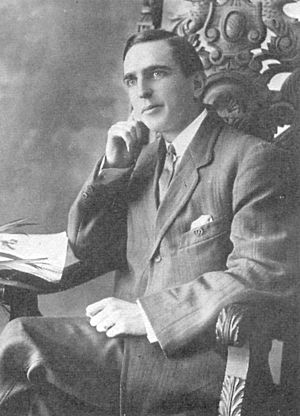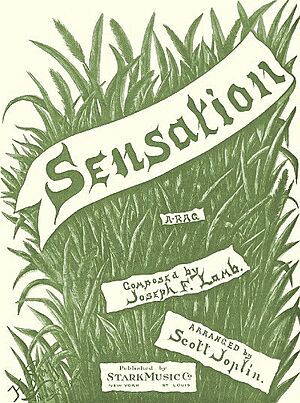Joseph Lamb (composer) facts for kids
Joseph Francis Lamb (born December 6, 1887 – died September 3, 1960) was an American musician. He was famous for composing ragtime music. Ragtime is a lively style of music, often played on the piano. Joseph Lamb was one of the "Big Three" composers of classic ragtime. The other two were Scott Joplin and James Scott. Lamb was special because he was the only one of the three who was not African American. His ragtime music was sometimes simple and popular. Other times, it was complex and very interesting. He learned about classical music from his sister. This helped him create long, flowing musical phrases. He also studied Scott Joplin's piano rags. This helped him understand how to structure his own music. By the 1950s, Joseph Lamb was a master of classic ragtime. He could play it very well, and his recordings show this.
Contents
Joseph Lamb's Life and Music Career
Joseph Lamb was born in Montclair, New Jersey. He was the youngest of four children. He taught himself how to play the piano. He really admired the early ragtime music published by Scott Joplin. In 1904, he left St. Jerome's College to work for a company that sold dry goods.
In 1907, Lamb met Scott Joplin. This happened when Lamb was buying new sheet music from John Stark & Son. Joplin was very impressed with the music Lamb had written. He suggested that ragtime publisher John Stark should publish Lamb's work. Stark agreed and published Lamb's music for the next ten years. His first published song was "Sensation."
Lamb's Ragtime Styles
From 1908 to 1919, John Stark published twelve of Lamb's rags. These songs can be put into two main groups.
One group is called "heavy" rags. These songs have strong melodies, like Joplin's style. They also use many different notes across the piano keyboard, like James Scott's music. Examples of these "heavy" rags include:
- "Ethiopia Rag" (1909)
- "Excelsior Rag" (1909)
- "American Beauty Rag" (1913)
- "Nightingale Rag" (1915)
- "The Top Liner Rag" (1916)
The other group is called "light" rags. These songs are inspired by the cakewalk tradition. They have melodies that use a smaller range of notes, similar to Joplin's style. Some of these "light" rags are:
- "Champagne Rag" (1910)
- "Cleopatra Rag" (1915)
- "Reindeer: Ragtime Two Step" (1915)
- "Bohemia Rag" (1919)
Some of Lamb's songs, like "Contentment Rag" (1915) and "Patricia Rag" (1916), have parts of both "heavy" and "light" styles. Lamb often repeated musical ideas in his songs. This helped his music grow and develop.
Later Life and Ragtime Revival
In 1911, Joseph Lamb married Henrietta Schultz. They moved to Brooklyn, New York. He worked as a music arranger for a publishing company. Later, in 1914, he became an accountant for another company.
Sadly, Henrietta died in 1920 from the flu. Around the same time, people's interest in popular music changed. They started listening more to jazz instead of ragtime. Because of this, Lamb stopped publishing his music. He still played and composed, but only as a hobby. His last published rag was "Bohemia Rag" in 1919.
In the 1950s, people became interested in ragtime music again. Joseph Lamb shared his memories of Scott Joplin and other early ragtime musicians with historians. Many people were surprised to learn that he was still alive and that he was white. He started composing new rags. He also brought out old songs that had never been published. He even made new recordings of his music.
One year before he passed away in 1960, an album of his music was released. It was called Joseph Lamb: A Study in Classic Ragtime. Joseph Lamb died in Brooklyn at age 72 from a heart attack.
Songs Not Published During His Life
Here are some of the ragtime songs Joseph Lamb wrote that were not published while he was alive:
- "Alabama Rag"
- "Alaskan Rag"
- "Arctic Sunset"
- "Bee Hive"
- "Bird-Brain Rag"
- "Blue Grass Rag"
- "Chasin' the Chippies"
- "Chime In"
- "Cinders"
- "Cottontail Rag"
- "Crimson Ramblers"
- "Firefly Rag"
- "Good and Plenty Rag"
- "Greased Lightning"
- "Hot Cinders"
- "Jersey Rag"
- "Joe Lamb's Old Rag"
- "The Old Home Rag"
- "Ragged Rapids Rag"
- "Ragtime Bobolink"
- "Ragtime Special"
- "Rapid Transit Rag"
- "Shootin' the Works"
- "Thoroughbred Rag"
- "Toad Stool Rag"
- "Walper House Rag"
See also
 In Spanish: Joseph Lamb para niños
In Spanish: Joseph Lamb para niños




